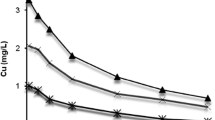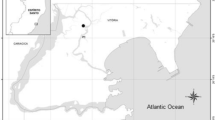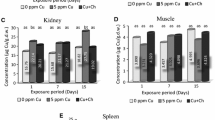Abstract
Cu accumulation and depuration in various tissues of the crayfish Astacus leptodactylus was investigated. Adult specimens were exposed to 0.5, 2.5 and 5.0 mg Cu/L under static conditions for three weeks. At the end of the 3rd week the specimens were divided into three groups and left in dechlorinated water for either 1, 2 or 3 weeks for depuration. After 7, 14 and 21 days, four crayfish from each group were instantaneously sacrificed. All crayfish were dissected into their hepatopancreas, gill, abdominal muscle and exoskeleton tissues for evaluation of Cu accumulation in each. The following accumulation pattern was obtained in decreasing order; hepatopancreas > gills > exoskeleton > abdominal muscles with values of 94.13, 84.86, 66.13 and 11.43 mg/L, respectively. The observed Cu depuration throughout the study was found to be time-dependent. Based on the present work we conclude that crayfish has a great potential for rapid accumulation and depuration of Cu in fresh water.
Similar content being viewed by others
References
Alikhan, M. A., & Zia, S. (1989). A laboratory study of the copper and nickel uptake and regulation in a copper-tolerant decapod, Cambarus bartoni (Fabricius). Bulletin of Environmental Contamination and Toxicology, 42(1), 103–110.
Allinson, G., Laurenson, L., Pistone, G., Stagnitti, F., & Jones, P. L. (2000). Effects of dietary copper on the Australian freshwater crayfish Cherax destructor. Ecotoxicology and Environmental Safety, 46(117), 123.
Anderson, M. B., Reddy, P., Preslan, J. E., Fingerman, M., Bollinger, J., & Jolibois, L. (1997a). Acute toxity of heavy metals (Cr, Cd and Hg) to freshwater crayfish Procambarus clarkii (Girard). Bulletin of Environmental Contamination and Toxicology, 38, 736–741.
Anderson, M. B., Reddy, P., Preslan, J. E., Fingerman, M., Bollinger, J., Jolibois, L., et al. (1997b). Metal accumulation in crayfish, Procambarus clarkii, exposed to a petroleum-contaminated bayou in Louisiana. Ecotoxicology and Envıronmental Safety, 37, 267–272.
Anonymous. (2002). Fisheries Statistics of Prime Ministry State Planning Organization, Republic of Turkey, Ankara, Turkey.
Bagatto, G., & Alikhan, M. A. (1987). Copper, cadmium and nickel accumulation in crayfish populations NEAR copper-nickerl smelters at subbury, Ontario, Canada. Bulletin of Environmental Contamination and Toxicology, 38, 540–545.
Bryan, G. W. (1968). Concentration of zinc & copper in tile tissues of decapod crustaceans. Journal of the Marine Biological Association of the United Kingdom, 48, 303–321.
Christopher, L. R., William, A. H., Zehnde, C., & Justin, D. C. (2001). Metabolic costs incurred by crayfish Procambarus acutus in a trace element-polluted habitat: Further evidence of similar responses among diverse taxonomic groups. Comparative Biochemistry and Physiology Part C, 129, 275–283.
Eiseler, R. (1998). Copper hazards to fish, wildlife, and invertebrates: A synoptic review. U.S. Geological Survey, Biological Resources Division, Biological Science Report USGS/BRD/BSR, 1998–2002. 98.
Harlioğlu, M. M., Barim, O., Türkgülü, & Harlioğlu, A. G. (2004). Potential fecundity of an introduced population of freshwater crayfish, Astacus leptodactylus leptodactylus (Eschscholtz, 1823). Aquaculture, 230, 189–195.
Icely, J. D., & Noot, J. A. (1992). Digestion and absorption: Digestive system and associated organs. In F. W. Harison (Ed.), Microscopic Anatomy of Invertebrates (Vol. 10, pp. 147–201).
Mackeviciene, G. (2002). Bioaccumulation of heavy metals in noble crayfish (Astacus astacus) tissues under aquaculture conditions. Ekologija (Vilnius) 2, 79–82.
Naqvi, S. M., Devalraju, I., & Naqvi, N. H. (1998). Copper bioaccumulation and depuration by red swamp crayfish, Procambarus clarkii. Bulletin of Environmental Contamination and Toxicology, 61, 65–71.
Rainbow, P. S. (1997). Ecophysiology of trace metal uptake in crustaceans, estuarine. Coastal and Shelf Science, 44, 169–175.
Rainbow, P. S., & White, S. L. (1989). Comparative strategies of heavy metal accumulation by crustaceans: zinc, copper and cadmium in a decapod, an amphipod and a barnacle. Biomedical and Life Sciences and Earth and Environmental Science, 174(3), 245–262.
Torreblanca, A., Del Ramo, J., Arnau, J. A., & Diaz-Mayans, J. (1989). Cadmium, mercury, and lead effects on gill tissue of freshwater crayfish Procambarus clarkii (Girard). Biological Trace Element Research, 21, 343–347.
White, D. L., & Rainbow, P. S. (1982). Regulation and accumulation of copper, zinc and cadmium by the shrimp Palaemon elegans. Marine Ecology. Progress Series, 8, 95–101.
Author information
Authors and Affiliations
Corresponding author
Rights and permissions
About this article
Cite this article
Guner, U. Freshwater crayfish Astacus leptodactylus (Eschscholtz, 1823) accumulates and depurates copper. Environ Monit Assess 133, 365–369 (2007). https://doi.org/10.1007/s10661-006-9590-1
Received:
Accepted:
Published:
Issue Date:
DOI: https://doi.org/10.1007/s10661-006-9590-1




